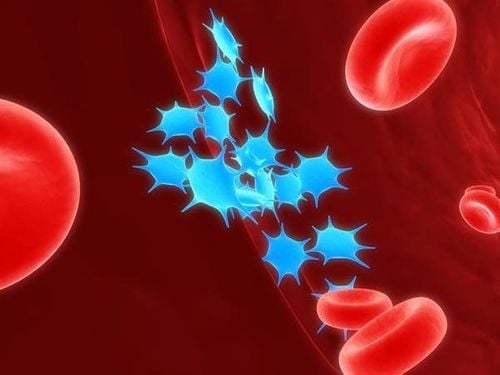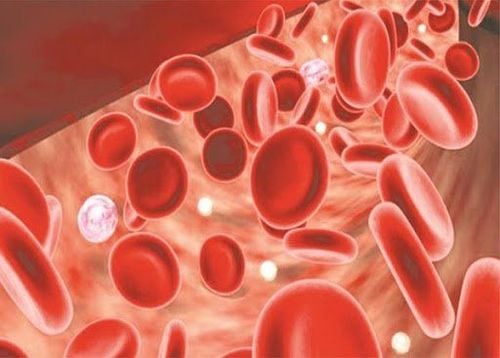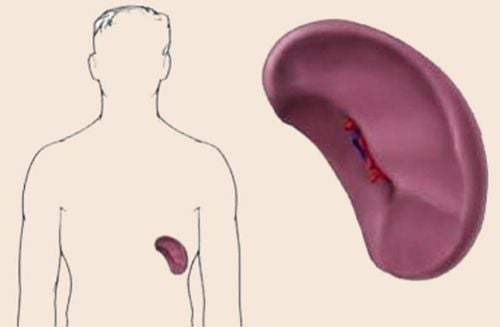This is an automatically translated article.
For cases with abnormal spleen problems, it is necessary to check, diagnose and treat early to avoid the risk of a life-threatening splenic rupture accident. Laparoscopic splenectomy is the indicated method for cases of hypersplenism, thrombocytopenia bleeding, hemolytic anemia,...
1. The basic role of the spleen
The spleen is a large mass of blood vessels and lymphatic tissue. This organ is located in the left quadrant of the abdomen, in a cavity formed by the diaphragm, stomach, left kidney and left adrenal gland, the ligament of the diaphragm, the colon, and the chest wall. In an adult, normal spleen has an average weight of 150g, with a limit of 80-300g. The size of the spleen is usually 9-11cm long, 7cm wide and 4cm thick.
Physiological functions of the spleen include:
Immune function: The spleen secretes many antibodies against antigens entering the blood stream; Hematopoiesis: During the embryonic period, the spleen participates in the production of red blood cells and granulocytes. Then, when the baby is born, the spleen produces lymphocytes; Destroys blood cells: The spleen is responsible for controlling the quality of blood cells as they pass through the spleen. The spleen destroys old, abnormal cells or platelets that no longer function; Blood storage: The spleen stores about 1/3 of the number of platelets and 30ml of red blood cells for the body, which can replenish blood in an emergency.

Lách là nơi tích trữ và bổ sung máu cho cơ thể
2. Indications for laparoscopic splenectomy
2.1 Autoimmune thrombocytopenic purpura The disease is characterized by thrombocytopenia, splenectomy is indicated when the disease is severe, does not respond or responds poorly to medical treatment, the platelet count is less than 20,000/mm3. Splenectomy helps to cure completely or long-term with the rate of 70% in children and 60 - 80% in adults;
2.2 Thrombotic thrombocytopenic purpura is a rare disease, characterized by symptoms of fever, thrombocytopenia, hemolytic anemia, renal failure and neurological disorders. Splenectomy is indicated in the case of plasmapheresis failure or disease recurrence upon discontinuation of medical therapy.
2.3 Autoimmune hemolytic anemia This is the result of abnormal antibody formation, which causes red blood cell breakdown. Usually, splenectomy is indicated when medical treatment after 1 year has no results and will give better results in patients under 40 years of age. The response rate after splenectomy is about 50 - 80%;
2.4 Hemolytic anemia due to abnormalities in enzymes in red blood cells The disease usually has symptoms of anemia, splenomegaly, gallstones. Indications for splenectomy, although not eliminating hemolysis, but helping to increase hemoglobin content, reducing the need for blood transfusion in patients;

Cắt lách giúp giảm như cầu truyền máu cho người bệnh
2.5 Abnormalities of red blood cell membranes Small spherical red blood cells : The most common pathology in the abnormal red blood cell membranes indicated splenectomy. Splenectomy will reduce the rate of hemolysis, solving anemia. Of note, patients with small red blood cells have a high risk of gallstones, so an abdominal ultrasound should be performed before splenectomy. If gallstones are present, cholecystectomy should be performed during splenectomy. Hereditary ellipsoidal erythrocytes: Due to abnormality of the red blood cell membrane and increased destruction of red blood cells. Splenectomy is indicated when there is severe hemolytic anemia; 2.6 Primary hypersplenism Splenectomy relieves symptoms caused by splenomegaly, improves blood cell deficiency, and eliminates the possibility of underlying malignancy;
2.7 Bone marrow failure Indications splenectomy for patients with bone marrow failure of unknown cause helps prolong the life of red blood cells, increases the number of platelets because there is no place to destroy platelets. At the same time, splenectomy also helps to reduce the amount of toxic T-activated antibodies, release the marrow and restore hematopoiesis in the marrow;
2.8 Lymphoma Hodgkin's Disease: Laparoscopic splenectomy to identify early stage disease (I and II) when other diagnostic means are not clear; Non-Hodgkin lymphoma : Symptomatic splenomegaly (hypersplenism). Indications for splenectomy can be used as a diagnostic or therapeutic measure when splenomegaly causes symptoms of rapid satiety, abdominal pain, discomfort, anemia, thrombocytopenia and polymorphonuclear leukopenia;

Cắt lách được chỉ định khi bệnh nhân đau bụng khó chịu do cường lách
2.9 Leukemia Hair Cell Leukemia : Splenectomy previously played a role in the treatment of patients but is now rarely indicated; Chronic lymphocytic leukemia: Splenectomy helps prolong survival time for patients; Chronic myeloid leukemia: Splenectomy helps to reduce disease symptoms, improve blood cell reduction; Other indications: Splenic abscess, splenic cyst, aneurysm in the splenic artery, blood clot in the blood vessel of the spleen.
3. Contraindications for laparoscopic splenectomy
Blood clotting disorder, severe heart or lung disease; Spleen size too large (grade IV); Enlarged spleen in cases of bone marrow proliferative disorders; portal hypertension; Severe splenic injury.

Phẫu thuật nội soi cắt lách không thực hiện khi bệnh nhân mắc các bệnh tim mạch
4. Laparoscopic splenectomy
Currently, laparoscopic surgery is the standard method for most cases of splenectomy. The aim of surgery is to remove the entire spleen and accessory spleen (if present), and at the same time avoid tearing the spleen. In cases where an intact spleen is needed for diagnosis, an additional incision may be needed.
Advantages of laparoscopic splenectomy compared with traditional open surgery:
Better observation and access to the surgical field, especially because the spleen is an organ located deep in the abdomen; Less pain after surgery, faster recovery after surgery; After surgery, there is little effect on respiratory function; Rarely complications related to the incision; Smaller surgical scars, more aesthetic. Disadvantages of laparoscopic splenectomy compared with traditional open surgery:
The operation time is usually longer. Laparoscopic splenectomy is suitable for medium and medium sized spleens; Difficulty controlling bleeding, requiring a surgeon with extensive experience; The detection rate of accessory spleen is less than open surgery; Invest in expensive equipment.

Nội soi cắt lách đòi hỏi đầu tư các trang thiết bị hiện đại
5. Complications and how to manage after laparoscopic splenectomy
The rate of complications depends on the surgeon's experience, the size and weight of the armpit, the weight and age of the patient,... Common complications of splenectomy include:
Bleeding blood: Manage by monitoring, blood transfusion or if necessary to re-operate to stop bleeding; Residual abscess of the splenic fossa: Needs aggressive antibiotic treatment. If the abscess is large, it may be necessary to aspirate under ultrasound; Infection of the trocar holes: Perform active antibiotic treatment, and clean and change the wound dressing daily; Deep vein thrombosis: The treatment is to increase exercise and treat fibrinolysis; Pancreatitis: Should be treated in the direction of acute pancreatitis; Injury to adjacent organs: Pancreas, stomach, colon and diaphragm. The treatment depends on the damage to the organs; Complications of laparoscopic surgery in general: Appropriate management of lesions and complications. Laparoscopic splenectomy should be performed promptly as soon as the diagnosis is confirmed to avoid life-threatening complications. During laparoscopic splenectomy, the patient should strictly follow the doctor's instructions.
To register for examination and treatment at Vinmec International General Hospital, for detailed information and to book an appointment for medical examination and consultation, customers can call the hotlines of the hospitals or register for an online consultation with Vinmec International General Hospital HERE













